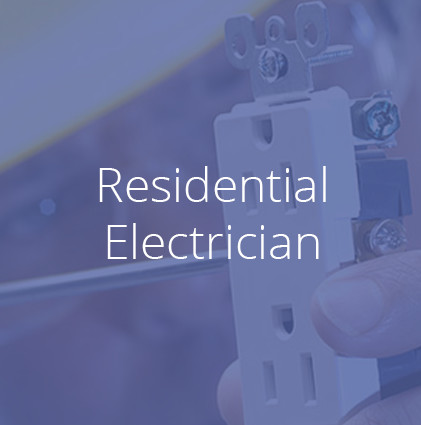Electrical Services
How is it broken down? Here are the most common types of services of Electricians that you or a client might need to hire depending on your specific need. The types of Electricians are based off of the kind of license that particular Electrician has opted to receive.

A residential electrician will be able to install, maintain, and repair any electrical systems and components in living areas or around living areas. Most of these types of electricians will attend a schooling of some sort and then work under a more qualified electrician for four years before being able to obtain a license. In addition to being an apprentice, individuals must pass an examination in order to become certified as a residential electrician.

A Journeyman Electrician is a mid-level Electrician who has not yet advanced to Master Electrician status, but is much more experienced than an apprentice or trainee. The purpose of this is to ensure that electricians are fully prepared and versed in state and local laws and guidelines as well as safety procedures before the electrician is able to handle more complex jobs without supervision.


A circuit consists of a hot (usually black) wire that goes from the main panel to lights, receptacles, or appliances, and a neutral (usually white) wire which returns to the main panel. In addition to these wires, a grounding wire (usually green or un-insulated) also returns to the main panel.
How does a residential or commercial electrical system work?
Electricians Uncovered
Qualifications & Skills
Now that you have a general understanding of how a basic electrical system functions, let’s discuss the career path one would take to become an electrician.
Certificate IV
State licensing. Most states require that you get a state license in order to practice as an electrician. The license is granted after taking an exam to demonstrate knowledge of the National Electrical Code and local electrical and building codes.
In order to take the exam, the following must be completed:


Certificate V
Certification. This is entirely optional. from a variety of specialized certifications to enhance your career. Certifications vary by state and will help you pursue work as an electrical administrator, a telecommunications contractor, or a specialist in an area like instrumentation.
Certificate III
Electrician apprentice program. Most states require at least two years to start, and in most cases up to four years, of apprenticeship with a master or licensed electrician before one can take the examination to become a licensed electrician. During an apprenticeship, one earns the title of journeyman electrician. Many apprenticeships combine hands-on experience with classroom instruction.
Some popular organizations that sponsor or provide apprentice programs through local chapters include:

- International Brotherhood of Electrical Workers
- National Electrical Contractors Association
- Independent Electrical Contractors Association
- Associated Builders and Contractors
Certificate II
Trade school, vocational program or college in order to prepare you for entering an electrician apprenticeship program.


Certificate I
(Basic Requirements)
High School Diploma or GED
-------
--------
--------
--------
-------
-------------------------------------------
--------------------------------------------------------------------------------------------
------------------------------------------------------------------------------------------
----------------------------------------
-------------------------------------------------------------
Subpanels in other locations of the house, connect to the main panel and provide power to areas that have a number of different circuits or large appliances, such as the kitchen and laundry room. They also are equipped with a secondary set of circuit breakers. Low-voltage electrical systems are also common in houses for powering doorbells, intercoms, sprinkler timers, outdoor lighting, and some types of low-voltage indoor lighting.

An electrician is a tradesperson who can install and maintain electrical systems in homes, businesses, and commercial structures. Simply put, an electrician is responsible for getting electricity from a source to where it is needed. To achieve this without endangering the public, he or she must have a good working knowledge of the relevant electrical codes as well as the ability to translate electrical systems from a set of blueprints into actual practice.
Electricians are essential to our standard of living. Without them there would be no power for lights, computers, or televisions. Depending on the type of Electrician, they will also repair all electric machines or work in factories fixing motors, generators, and robots.
What is an Electrician?
These wires establish a 240-volt circuit for large appliances such as air conditioners and electric furnaces as well as a lower voltage lines of 110-volts to power lights and outlets. In order to monitor your homes activity, an electric meter, monitored by your electric utility company, is typically mounted outside where the electricity enters your home. The main panel is usually right next to or under the meter itself. This is the central distribution point for electrical circuits that run to lights, receptacles, and appliances throughout the house. A circuit, by definition, is a circular journey that begins and ends at the same place, and this is essentially how electricity works. Current begins at a power source, powers the appliance or device along the circuit, and then returns to the power source. Any interruption in this path will render the circuit dead.
Electricity has become an essential part of our lives - it powers lights, appliances, heat and air conditioning units, televisions, computers and much more. Let’s focus on residential or home electrical units for this discussion as this will most likely be the more common system our clients will run into.
Electricity arrives to a home through a local utility company via overhead power lines or underground through a conduit. Most homes have a three-wire service - one hot wire, one neutral, and a ground. Throughout the house, one hot wire and one neutral wire will power conventional lights and appliances. The ground wire provides a path for electrical current to pass safely into the ground without danger to anyone in the event of a short circuit.

- Candidates must show proof of working as an electrician and having completed an apprenticeship program. State requirements typically call for four to seven years' experience in the trade prior to taking this test.
- You must complete an examination application and submit appropriate fees before taking the exam.
Sources
Information Sources